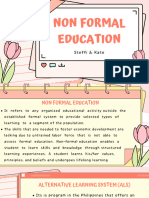Joy Ella P. Baluran EDM - 518 Management Alternative Learning System
Joy Ella P. Baluran EDM - 518 Management Alternative Learning System
Uploaded by
Claudine Toledo PableoCopyright:
Available Formats
Joy Ella P. Baluran EDM - 518 Management Alternative Learning System
Joy Ella P. Baluran EDM - 518 Management Alternative Learning System
Uploaded by
Claudine Toledo PableoOriginal Title
Copyright
Available Formats
Share this document
Did you find this document useful?
Is this content inappropriate?
Copyright:
Available Formats
Joy Ella P. Baluran EDM - 518 Management Alternative Learning System
Joy Ella P. Baluran EDM - 518 Management Alternative Learning System
Uploaded by
Claudine Toledo PableoCopyright:
Available Formats
UNIVERSITY OF MAKATI
COLLEGE OF CONTINUING ADVANCED AND PROFESSIONAL STUDIES
EDM 518 MANAGEMENT OF ALTERNATIVE LEARNING SYSTEM
In Partial Fulfillment
Of the Requirements for the Subject
In EDM 518 MANAGEMENT OF ALTERNATIVE LEARNING SYSTEM
Submitted to:
DR. GLORIA VALDEZ
Submitted by:
Joy Ella P. Baluran
SEPTEMBER 2020
JOY ELLA P. BALURAN
EDM – 518
MANAGEMENT ALTERNATIVE LEARNING SYSTEM
NON FORMAL EDUCATION IN SCHOOL SYSTEM AND OUTSIDE THE SCHOOL
SYSTEM
ALTERNATIVE LEARNING SYSTEM (NON FORMAL EDUCATION IN THE SCHOOL
SYSTEM)
WHAT IS ALTERNATIVE LEARNING SYSTEM OR ALS?
It is a parallel learning system in the Philippines that provides a practical option to the
existing formal instruction. When one does not have or cannot access formal
education in schools, ALS is an alternate or substitute. ALS includes both the non-
formal and informal sources of knowledge and skills.
WHY IS THERE A NEED FOR ALTERNATIVE LEARNING SYSTEM IN THE
PHILIPPINES?
Many Filipinos do not have a chance to attend and finish formal basic education
(Grades 1-6 and Year 1-4) due to many reasons. Some drop out from schools while
some do not have schools in their communities. Since every Filipino has a right to free
basic education, the Government establishes ALS to provide all Filipinos the chance to
have access to and complete basic education in a mode that fits their distinct
situations and needs
THE ALS K TO 12 BASIC EDUCATION CURRICULUM
The ALS Program uses a contextualized non-formal curriculum which is substantially
aligned with the K to 12 Curriculum for Basic Education of the formal school system,
but it is not the mirror image of the formal school curriculum. It is aligned but not
identical. This takes into account the prior learning of its learners and reflects the
indicators of functional literacy into six interrelated learning strands.
HOW DOES ALS WORK?
There are two major programs on ALS that are being implemented by the Department
of Education, through the Bureau of Alternative Learning System (BALS). One is the
Basic Literacy Program and the other is the Continuing Education Program –
Accreditation and Equivalency (A&E). Both programs are modular and flexible. This
means that learning can take place anytime and any place, depending on the
convenience and availability of the learners
Technical Education and Skills Development Authority (NON FORMAL
EDUCATION OUTSIDE THE SCHOOL SYSTEM)
The Technical Education and Skills Development Authority (TESDA)
FILIPINO: Pangasiwaan sa Edukasyong Teknikal at Pagpapaunlad ng Kasanayan)
serves as the Philippines' Technical Vocational Education and Training (TVET)
JOY ELLA P. BALURAN
EDM – 518
MANAGEMENT ALTERNATIVE LEARNING SYSTEM
authority. As a government agency, TESDA is tasked to both manage and supervise
the Philippines' Technical Education and Skills Development (TESD). Its goals are to
develop the Filipino workforce with "world-class competence and positive work values"
and to provide quality technical-educational and skills development through its
direction, policies, and programs.
Training systems
TVET is classified into two main systems: the formal system and the non-formal
system.[The formal system is a post-secondary technical education of six months to
three years which entitles a student or trainee to a certificate in a specialized field.
Programs under the formal system are delivered by both private and public vocational-
technical schools. The non-formal system, on the other hand, consists of a variety of
short-term programs usually up to six months targeting a special group of clientele.
This includes those seeking employment in the government, special-interest
organizations, services and salesmanship, farming, and forestry and fishing.
ClientelE
TVET clientele is primarily composed of high school graduates, secondary school
dropouts, and college graduates and undergraduates looking to gain the necessary
skills in various sectors. TVET also considers part of their targeted clientele those who
are unemployed but actively looking for work, Overseas Filipino Workers (OFWs)
returning to the Philippines permanently to work, and those currently employed
wanting to enhance or acquire new skills.
Delivery modes
TESDA undertakes direct training provisions in order to provide TVET clients access to
the various Technical Education Skills Development (TESD) programs offered. The
following are the four training modalities:
School-based: Formal delivery by the schools of TVET programs of varying
duration of at least a year but not exceeding three years.
Centre-based: Provision of short duration non-formal training undertaken in
TESDA Regional and Provincial Training Centers.
Community-based: Training programs specifically designed to answer the needs
for skills training in the community to facilitate self-employment.
Enterprise-based: Training programs like apprenticeship, learner ship, and dual
training which are carried out within the firms or industries.
Training programs
TESDA provides direct training programs which are divided into four distinct training
modalities: School-Based Programs, Center-Based Programs, Community-Based
Programs, and Enterprise-Based Programs.
School-based programs
School-based programs are TVET programs that are directly delivered or provided by
TESDA-administered schools. Currently, there are 57 TESDA-administered schools,
19 of which are agriculture schools, 7 are fishery schools and 31 are trade schools.
JOY ELLA P. BALURAN
EDM – 518
MANAGEMENT ALTERNATIVE LEARNING SYSTEM
School based programs include post-secondary offerings of varying duration not
exceeding three years.
Center-based programs
These are training provisions or programs that are being offered in TESDA Regional
and Provincial Centers throughout the country. There are fifteen (15) Regional Centers
and forty-five (45) provincial centers, adding up to a total of 60 centers that provide
center-based programs. Such programs are offered under selected trade areas in the
different regions and provinces of the country.
The TESDA Training Center Taguig Campus Enterprise (TTCTCE) provides advanced
technology training programs that are registered under the Unified TVET Program
Registration and Accreditation System (UTPRAS). The TTCTCE conducts these training
programs in partnership with industry organizations under a co-management scheme
in response to a given industry's training requirements. [30]
TESDA is also the implementing agency of three grant assistance projects from
the Government of the Republic of Korea. The Korea-Philippines Information
Technology Training Center (KPITTC), located at the Polytechnic University's Quezon
City compound in Novaliches provides training on computer graphics and animation.
Another grant assistance project from the Republic of Korea's government that is
under the implementation of TESDA is the KPITTC located at the Regional Skills
Development Center in Guiguinto, Bulacan.
Enterprise-based programs
Enterprise-based programs are training programs that are being implemented within
companies or firms. There are several programs being offered by TESDA that fall
under enterprise-based programs.
The Apprenticeship Program is a training and employment program that involves a
contract between an apprentice and an employer in an occupation that has been
approved for apprenticeship. The period of apprenticeship covers a minimum of four
months and a maximum of six months. Only companies with approved and registered
apprenticeship programs under TESDA can hire apprentices.
The Learnership Program, on the other hand, involves practical on-the-job training for
pre-approved learnable occupations, as determined by TESDA. The program must not
exceed three months. Only companies with TESDA approved and registered
learnership programs can hire learners.
The Dual Training System involves an instructional mode of delivery for technology-
based education and training in which learning takes place alternatively in two
venues: the school or training center, and the company. One of the strategic
approaches on this program is the conversion of selected industry practices/ programs
registered under the apprenticeship program into DTS modality. Schools or training
centers and business establishments interested in adopting the dual training system
must apply for accreditation with TESDA.
Community-based programs
TESDA also provides community-based programs, which are primarily offered to those
belonging to marginalized groups. These are intended to expand educational access to
JOY ELLA P. BALURAN
EDM – 518
MANAGEMENT ALTERNATIVE LEARNING SYSTEM
those who are unable to access, or are not accessible, by formal training provisions
and programs. The program is also designed to assist partner agencies such as LGUs,
NGOs, people organizations and other agencies and organizations with regard to their
poverty-alleviation and livelihood programs.
Scholarship programs
These are programs created to give help and financial assistance to deserving TVET
enrollees and trainees in the country.
JOY ELLA P. BALURAN
EDM – 518
MANAGEMENT ALTERNATIVE LEARNING SYSTEM
You might also like
- Benefits of Eteeap FinalDocument23 pagesBenefits of Eteeap FinalDj22 Jake100% (2)
- Assignment 1.1 POT22003424Document7 pagesAssignment 1.1 POT22003424vineet panwar100% (2)
- Overview of Philippine EducationDocument45 pagesOverview of Philippine Educationmarkjosephbual14No ratings yet
- Course Packet 01 Introduction To TVETDocument8 pagesCourse Packet 01 Introduction To TVETEly gyNo ratings yet
- MAED - Management of Educational InstitutionDocument9 pagesMAED - Management of Educational InstitutionAnn Rachel CuadraNo ratings yet
- TESDADocument14 pagesTESDALEVY ALVAREZNo ratings yet
- Presented To Mr. Roldan GalladoraDocument5 pagesPresented To Mr. Roldan GalladoraAiren UnabiaNo ratings yet
- Cpe101 TesdaDocument24 pagesCpe101 Tesdagh52j6nrt5No ratings yet
- Ched Projects and DevelopmentDocument30 pagesChed Projects and DevelopmentCecille Alfornon QueniahanNo ratings yet
- Phil TVET System - SyjucoDocument18 pagesPhil TVET System - SyjucoKiril Van Abid Aguilar100% (1)
- Phil TVET System - SyjucoDocument18 pagesPhil TVET System - SyjucosirjudsNo ratings yet
- Internalization of EducationDocument2 pagesInternalization of EducationMarc MaglonzoNo ratings yet
- Chapter I Mam Blanch SUDocument29 pagesChapter I Mam Blanch SUEmi Cueva100% (1)
- Alternative Learning SystemDocument10 pagesAlternative Learning SystemMylz VillarinNo ratings yet
- ALS IMPLEMENTERS. Doc. Luisito CantosDocument5 pagesALS IMPLEMENTERS. Doc. Luisito CantosMyca HernandezNo ratings yet
- Knowing The TESDA Part 2Document1 pageKnowing The TESDA Part 2Regine GierzNo ratings yet
- TANEDO, DK - DISSERTATION 2019 (PHD) As of 03APRIL2019Document87 pagesTANEDO, DK - DISSERTATION 2019 (PHD) As of 03APRIL2019Donards Kim Abracia TañedoNo ratings yet
- Chapter 1Document49 pagesChapter 1xxxxNo ratings yet
- FrameworkDocument62 pagesFrameworkDaniel Vinluan Jr.No ratings yet
- The Teacher and The School Curriculum PDFDocument14 pagesThe Teacher and The School Curriculum PDFLeah Mae T. Acaso100% (1)
- List of Programs and Projects As of September 2020 10012020Document6 pagesList of Programs and Projects As of September 2020 10012020Chan Chanielou JavierNo ratings yet
- Singapore EducationDocument14 pagesSingapore EducationallisjoNo ratings yet
- The Technical Vocational Livelihood Track at Senior High School Is Not Yet Ready For ImplementationDocument5 pagesThe Technical Vocational Livelihood Track at Senior High School Is Not Yet Ready For ImplementationMark Lawrence100% (1)
- Alternative Learning SystemDocument4 pagesAlternative Learning SystemRudyard MoranteNo ratings yet
- Reaching The Target Population of The Non Formal EducationDocument3 pagesReaching The Target Population of The Non Formal EducationAngela Tinio LomagdongNo ratings yet
- TVET ManagementDocument99 pagesTVET ManagementBizuneh getuNo ratings yet
- Research PaperDocument54 pagesResearch PaperNadya de LeonNo ratings yet
- Philippine Standards in Basic Education Higher EducationDocument25 pagesPhilippine Standards in Basic Education Higher Educationbugtaycarlos17No ratings yet
- Earn While You LearnDocument7 pagesEarn While You Learnprathameshmestri94No ratings yet
- Educ 65 Intro Part1 Legal BasesDocument41 pagesEduc 65 Intro Part1 Legal BasesAngelica AguirreNo ratings yet
- Group 1: TVL Track Is Designed To Improve Students With Job Ready Skills That They Will Need in The FutureDocument19 pagesGroup 1: TVL Track Is Designed To Improve Students With Job Ready Skills That They Will Need in The FutureIanne GarciaNo ratings yet
- Chapters 1 - 5Document135 pagesChapters 1 - 5Donards Kim Abracia TañedoNo ratings yet
- Accreditation of Prior Experiential LearningDocument20 pagesAccreditation of Prior Experiential LearningEverboleh ChowNo ratings yet
- Technical Education and Skills Development Authority: MandateDocument4 pagesTechnical Education and Skills Development Authority: MandateAnonymous qYXkMyoxNo ratings yet
- INTRODUCTIONDocument3 pagesINTRODUCTIONJohnwell BatiquinNo ratings yet
- Bone and Bane (2020) Flores CHAPTER 1Document13 pagesBone and Bane (2020) Flores CHAPTER 1Mavien Rey Razonable QuisilNo ratings yet
- Lesson2 - Dual TrainingDocument26 pagesLesson2 - Dual TrainingCristopher Sardon100% (2)
- Group 1 Ped 307Document19 pagesGroup 1 Ped 307Emman CervantesNo ratings yet
- Non Formal EducationDocument6 pagesNon Formal EducationpiaangNo ratings yet
- DepEd Strategic PlanDocument10 pagesDepEd Strategic Planlawrence abalosNo ratings yet
- TVET MGT 111 EeeeDocument130 pagesTVET MGT 111 EeeeFikadu GadisaNo ratings yet
- Als Action Research - EdictedDocument18 pagesAls Action Research - Edictedalgen70% (10)
- Extent of Implementation of Continuous Improvement Program Thesis Chapters 1 To 3Document43 pagesExtent of Implementation of Continuous Improvement Program Thesis Chapters 1 To 3Evangeline Omadto100% (55)
- What Is ALSDocument2 pagesWhat Is ALSRaquel C. VillarinNo ratings yet
- Asem0909 PDFDocument14 pagesAsem0909 PDFTROY2ARCHILLESNo ratings yet
- Educ 111Document2 pagesEduc 111Prizzy ThegreatNo ratings yet
- EducationDocument2 pagesEducationCassandra BaacloNo ratings yet
- Advantages of K To 12 ProgramDocument2 pagesAdvantages of K To 12 ProgramAlvin John Benavidez SalvadorNo ratings yet
- Flores, Nenelyn A. - 2CDocument20 pagesFlores, Nenelyn A. - 2CNenelyn FloresNo ratings yet
- Flores, Nenelyn A. - 2CDocument20 pagesFlores, Nenelyn A. - 2CNenelyn Flores100% (2)
- Alternative Learning SystemsDocument1 pageAlternative Learning SystemsSabina LagriaNo ratings yet
- Philippine Standard Classification of Education 2008: Pambansang Lupon Sa Ugnayang Pang-EstadistikaDocument62 pagesPhilippine Standard Classification of Education 2008: Pambansang Lupon Sa Ugnayang Pang-EstadistikaLiezel DahotoyNo ratings yet
- 3.4.2 ALS, Open High Schools, Open UniversityDocument4 pages3.4.2 ALS, Open High Schools, Open UniversityIsaiah De GuzmanNo ratings yet
- Eighth Session of The Regional Convention of StudiesDocument10 pagesEighth Session of The Regional Convention of StudiesJjuulliiuuss SaarrabbiiaaNo ratings yet
- Unit 4Document10 pagesUnit 4kaicaras16No ratings yet
- Higher National Diploma in English: SliateDocument9 pagesHigher National Diploma in English: Sliatetheshannadun94No ratings yet
- The Philippine Alternative Learning System: Bridging Gaps in The SocietyDocument10 pagesThe Philippine Alternative Learning System: Bridging Gaps in The SocietyRaymon Raganet AbantoNo ratings yet
- Exploring The Perceived Benefits and Challenges of Technical Vocational Livelihood (TVL) Education in The Context of Css StrandDocument10 pagesExploring The Perceived Benefits and Challenges of Technical Vocational Livelihood (TVL) Education in The Context of Css StrandJohnwell BatiquinNo ratings yet
- Best Practices and Strategies for Career and Technical Education and Training: A Reference Guide for New InstructorsFrom EverandBest Practices and Strategies for Career and Technical Education and Training: A Reference Guide for New InstructorsNo ratings yet
- Um 030 Conduct of The Division Virtual Rollout of The Comprehensive Sexuality Education Cse For Supervisors School Heads and Teachers PDFDocument1 pageUm 030 Conduct of The Division Virtual Rollout of The Comprehensive Sexuality Education Cse For Supervisors School Heads and Teachers PDFClaudine Toledo PableoNo ratings yet
- 88-110 Tantri PDFDocument23 pages88-110 Tantri PDFClaudine Toledo PableoNo ratings yet
- Mickelson Erica PDFDocument107 pagesMickelson Erica PDFClaudine Toledo PableoNo ratings yet
- Maximo Estrella Elementary SchoolDocument5 pagesMaximo Estrella Elementary SchoolClaudine Toledo Pableo100% (3)
- Maximo Estrella Elementary SchoolDocument5 pagesMaximo Estrella Elementary SchoolClaudine Toledo PableoNo ratings yet
- Kindergarten: Quarter 1: Week 1 - I Am UniqueDocument11 pagesKindergarten: Quarter 1: Week 1 - I Am UniqueClaudine Toledo PableoNo ratings yet
- BIS Locker Manual InstructionDocument45 pagesBIS Locker Manual InstructionUnlock AllNo ratings yet
- User Manual of MIP HikAssistant Plug-Ins - V1.1 - 20180120Document42 pagesUser Manual of MIP HikAssistant Plug-Ins - V1.1 - 20180120Aggrey-Anthony DuncanNo ratings yet
- Finance Minister Pravin Gordhan's 2017 Budget SpeechDocument32 pagesFinance Minister Pravin Gordhan's 2017 Budget SpeechFadia Salie92% (13)
- Ricardoc LLCDocument1 pageRicardoc LLC衡治洲No ratings yet
- Exodus 1 6 Bible Studies SampleDocument13 pagesExodus 1 6 Bible Studies SampleArnold HailNo ratings yet
- British Customs and Traditions All Year RoundDocument34 pagesBritish Customs and Traditions All Year RoundAnaNo ratings yet
- Alaa Resume - v12.2Document1 pageAlaa Resume - v12.2alaaaliiNo ratings yet
- Traveler Stati WPS OfficeDocument7 pagesTraveler Stati WPS Officeajsalvador01234No ratings yet
- Laboratory Exercise No. 3: DNS Client: A. Viewing DHCP Client and DNS Client StatusDocument5 pagesLaboratory Exercise No. 3: DNS Client: A. Viewing DHCP Client and DNS Client StatusJaysonNo ratings yet
- KK Meri - 20240314 - 0001Document2 pagesKK Meri - 20240314 - 0001agus pratamaNo ratings yet
- English Project PDFDocument17 pagesEnglish Project PDFchirkankshit bulaniNo ratings yet
- Leadership - Course IntroductionDocument21 pagesLeadership - Course IntroductionHồ Kiều MỵNo ratings yet
- Book of Lehi - SecuredDocument35 pagesBook of Lehi - SecuredEliha NarineNo ratings yet
- Middle Age Empires Workbook:: Byzantine Islamic Russia Mongols Ming DynastyDocument36 pagesMiddle Age Empires Workbook:: Byzantine Islamic Russia Mongols Ming DynastyTaryn PlazasNo ratings yet
- Fernandez-Morera The Myth of The Andalusian Paradise PDFDocument9 pagesFernandez-Morera The Myth of The Andalusian Paradise PDFAnonymous CKMJCGawa7100% (1)
- Lsat India Reading Comprehension Sample Question With Answers 2018 1200Document6 pagesLsat India Reading Comprehension Sample Question With Answers 2018 1200ADITHI REDDY SOLIPURAM MSCS2018No ratings yet
- Potential Business and Staff Impact AnalysisDocument5 pagesPotential Business and Staff Impact AnalysisMichelle EsternonNo ratings yet
- Data Overview - SVN 2020 197 Operations Officer (CCCM) (2 Positions) (P2) Multiple Duty Stations YemenDocument4 pagesData Overview - SVN 2020 197 Operations Officer (CCCM) (2 Positions) (P2) Multiple Duty Stations YemenYasser Yousif Al-ahmadyNo ratings yet
- Case - Ticketing SystemDocument3 pagesCase - Ticketing SystemSubba88% (17)
- Sewell v. Bernardin CFAA Opinion PDFDocument14 pagesSewell v. Bernardin CFAA Opinion PDFMark JaffeNo ratings yet
- Dechen Tshering - 031907 - Telecommunication Industry AnalysisDocument20 pagesDechen Tshering - 031907 - Telecommunication Industry AnalysisBaken D Dhungyel100% (5)
- Lesbian Gay & Bisexual Patients: The Issues For General PracticeDocument2 pagesLesbian Gay & Bisexual Patients: The Issues For General PracticeJ KaNo ratings yet
- Group A Dictation Group B DictationDocument1 pageGroup A Dictation Group B DictationКостя ГарасьNo ratings yet
- Cse 371Document17 pagesCse 371Naima HossainNo ratings yet
- Salvation in The TribulationDocument4 pagesSalvation in The TribulationacqueNo ratings yet
- Personality, Stress and Coping Style FormDocument10 pagesPersonality, Stress and Coping Style FormThirumaathi ChellappanNo ratings yet
- In The Hon'Ble Chief Meropolitan Magistrate, Central Distt., Tis Hazari Courts, DelhiDocument2 pagesIn The Hon'Ble Chief Meropolitan Magistrate, Central Distt., Tis Hazari Courts, Delhijags jainNo ratings yet
- GS Cross Asset CarryDocument16 pagesGS Cross Asset CarryHarry MarkowitzNo ratings yet
- 1-1. Basics of Commercial Correspondence (For Distribution)Document22 pages1-1. Basics of Commercial Correspondence (For Distribution)Huyền ThanhNo ratings yet






























































































